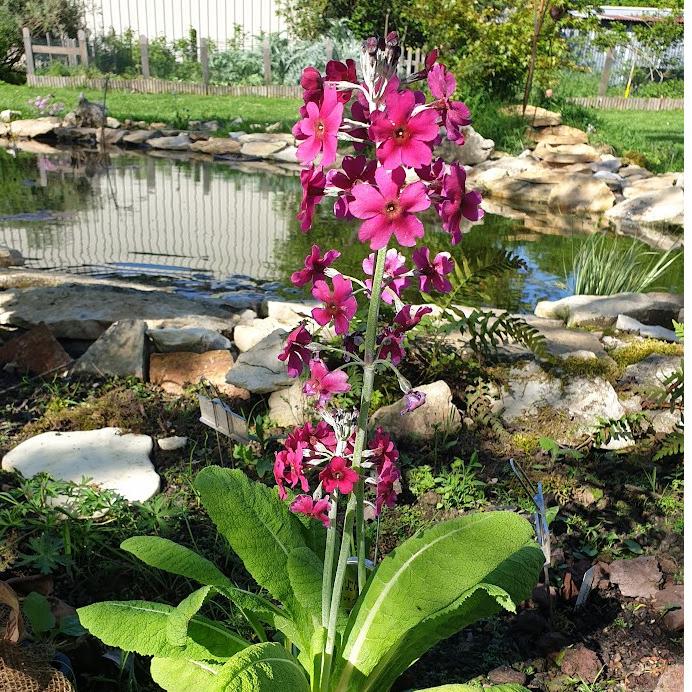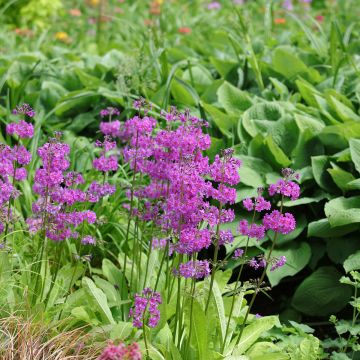

Primula pulverulenta - Mealy Primrose


Primula pulverulenta - Mealy Primrose


Primula pulverulenta - Mealy Primrose


Primula pulverulenta - Mealy Primrose
View more pictures
Hide images

Delphine C.

Delphine C. • 21 FR
Primula pulverulenta - Mealy Primrose
Primula pulverulenta
Mealy Primrose, Candelabra Primrose
Lovely primroses: planted in sets of 3 in November, in the shade with some dappled sunlight, they bloomed earlier than expected, from late March to mid-May approximately (oceanic temperate climate). Truly beautiful, I highly recommend them!
Isabelle, 29/10/2024
Special offer!
Receive a €20 voucher for any order over €90 (excluding delivery costs, credit notes, and plastic-free options)!
1- Add your favorite plants to your cart.
2- Once you have reached €90, confirm your order (you can even choose the delivery date!).
3- As soon as your order is shipped, you will receive an email containing your voucher code, valid for 3 months (90 days).
Your voucher is unique and can only be used once, for any order with a minimum value of €20, excluding delivery costs.
Can be combined with other current offers, non-divisible and non-refundable.
Home or relay delivery (depending on size and destination)
Schedule delivery date,
and select date in basket
This plant carries a 12 months recovery warranty
More information
We guarantee the quality of our plants for a full growing cycle, and will replace at our expense any plant that fails to recover under normal climatic and planting conditions.


Would this plant suit my garden?
Set up your Plantfit profile →
Description
The Primula pulverulenta is a particularly ornamental Candelabra Primrose. This perennial species from China produces tall flowering stems covered in a white bloom, a characteristic that earned it the name Pulverulent, or powdery, Primrose. They are adorned with beautiful clusters of flowers arranged in tiers, a deep purple-red color that contrasts beautifully with the white stems. This astonishing primrose thrives in partial shade or shade, in moist to wet, fertile, neutral to acidic soil, ideally at the edge of a shaded pond.
The Primula pulverulenta belongs to the primrose family, like all primroses. It grows in the wild in damp high-altitude meadows in the Chinese provinces of Sichuan. This perennial first produces a rosette of deciduous leaves, light green to acidic green, slender and dentate, measuring about twenty centimetres in length, including the petiole. The veins are visible on the leaves, which have a wavy appearance. Flowering occurs in June-July, in the form of tall, sturdy stems measuring 45 to 60 cm (18 to 24in), adorned with 4 to 10 whorls (clusters) each containing 4 to 12 tubular flowers, tightly packed together, typical of primroses. Their colour is a pure pinkish-red to cherry red or amaranth red, enclosed in a more or less pruinose jade green calyx. This vigorous and sturdy perennial readily self-seeds in moist soil.
This candelabra primrose is not widely spread in European gardens, but it is true that it has some requirements that may not be easy to meet everywhere. Resembling a red cuckoo, it appreciates moist to even waterlogged soils, humus-rich, with little or no limestone, even clayey. Hardy down to -15°C (5°F), it will enjoy the immediate proximity of a stream or pond, preferably in a semi-shaded location. Low maintenance, it thrives on its own by self-seeding randomly. In moist borders, it adds height and lightness to the broad foliage of rodgersias, Hart's-tongue Fern, or hostas. It also pairs well with its candelabra cousins Primula bulleyana and P. beesiana, Alchemilla mollis, Artemisia lactiflora, filipendulas, lysimachias, and astilbes. It can also be grown in a pot, in a consistently moist and organic-rich substrate.
Report an error about the product description
Primula pulverulenta - Mealy Primrose in pictures






Flowering
Foliage
Plant habit
Botanical data
Primula
pulverulenta
Primulaceae
Mealy Primrose, Candelabra Primrose
China
Other Primula - Primroses
View all →Planting and care
The Primula pulverulenta requires a moist location but any clayey and humus-bearing, non-calcareous soil, rich in organic matter, gives very good results. Choose a semi-shaded location, without burning sun. Divide large clumps in autumn. Rejuvenate the stumps every 3 years for beautiful flowering. Do not plant it too deeply as it is sensitive to "heart rot", a fungal disease.
Planting period
Intended location
Care
-
, onOrder confirmed
Reply from on Promesse de fleurs
Similar products
Haven't found what you were looking for?
Hardiness is the lowest winter temperature a plant can endure without suffering serious damage or even dying. However, hardiness is affected by location (a sheltered area, such as a patio), protection (winter cover) and soil type (hardiness is improved by well-drained soil).

Photo Sharing Terms & Conditions
In order to encourage gardeners to interact and share their experiences, Promesse de fleurs offers various media enabling content to be uploaded onto its Site - in particular via the ‘Photo sharing’ module.
The User agrees to refrain from:
- Posting any content that is illegal, prejudicial, insulting, racist, inciteful to hatred, revisionist, contrary to public decency, that infringes on privacy or on the privacy rights of third parties, in particular the publicity rights of persons and goods, intellectual property rights, or the right to privacy.
- Submitting content on behalf of a third party;
- Impersonate the identity of a third party and/or publish any personal information about a third party;
In general, the User undertakes to refrain from any unethical behaviour.
All Content (in particular text, comments, files, images, photos, videos, creative works, etc.), which may be subject to property or intellectual property rights, image or other private rights, shall remain the property of the User, subject to the limited rights granted by the terms of the licence granted by Promesse de fleurs as stated below. Users are at liberty to publish or not to publish such Content on the Site, notably via the ‘Photo Sharing’ facility, and accept that this Content shall be made public and freely accessible, notably on the Internet.
Users further acknowledge, undertake to have ,and guarantee that they hold all necessary rights and permissions to publish such material on the Site, in particular with regard to the legislation in force pertaining to any privacy, property, intellectual property, image, or contractual rights, or rights of any other nature. By publishing such Content on the Site, Users acknowledge accepting full liability as publishers of the Content within the meaning of the law, and grant Promesse de fleurs, free of charge, an inclusive, worldwide licence for the said Content for the entire duration of its publication, including all reproduction, representation, up/downloading, displaying, performing, transmission, and storage rights.
Users also grant permission for their name to be linked to the Content and accept that this link may not always be made available.
By engaging in posting material, Users consent to their Content becoming automatically accessible on the Internet, in particular on other sites and/or blogs and/or web pages of the Promesse de fleurs site, including in particular social pages and the Promesse de fleurs catalogue.
Users may secure the removal of entrusted content free of charge by issuing a simple request via our contact form.
The flowering period indicated on our website applies to countries and regions located in USDA zone 8 (France, the United Kingdom, Ireland, the Netherlands, etc.)
It will vary according to where you live:
- In zones 9 to 10 (Italy, Spain, Greece, etc.), flowering will occur about 2 to 4 weeks earlier.
- In zones 6 to 7 (Germany, Poland, Slovenia, and lower mountainous regions), flowering will be delayed by 2 to 3 weeks.
- In zone 5 (Central Europe, Scandinavia), blooming will be delayed by 3 to 5 weeks.
In temperate climates, pruning of spring-flowering shrubs (forsythia, spireas, etc.) should be done just after flowering.
Pruning of summer-flowering shrubs (Indian Lilac, Perovskia, etc.) can be done in winter or spring.
In cold regions as well as with frost-sensitive plants, avoid pruning too early when severe frosts may still occur.
The planting period indicated on our website applies to countries and regions located in USDA zone 8 (France, United Kingdom, Ireland, Netherlands).
It will vary according to where you live:
- In Mediterranean zones (Marseille, Madrid, Milan, etc.), autumn and winter are the best planting periods.
- In continental zones (Strasbourg, Munich, Vienna, etc.), delay planting by 2 to 3 weeks in spring and bring it forward by 2 to 4 weeks in autumn.
- In mountainous regions (the Alps, Pyrenees, Carpathians, etc.), it is best to plant in late spring (May-June) or late summer (August-September).
The harvesting period indicated on our website applies to countries and regions in USDA zone 8 (France, England, Ireland, the Netherlands).
In colder areas (Scandinavia, Poland, Austria...) fruit and vegetable harvests are likely to be delayed by 3-4 weeks.
In warmer areas (Italy, Spain, Greece, etc.), harvesting will probably take place earlier, depending on weather conditions.
The sowing periods indicated on our website apply to countries and regions within USDA Zone 8 (France, UK, Ireland, Netherlands).
In colder areas (Scandinavia, Poland, Austria...), delay any outdoor sowing by 3-4 weeks, or sow under glass.
In warmer climes (Italy, Spain, Greece, etc.), bring outdoor sowing forward by a few weeks.



















































